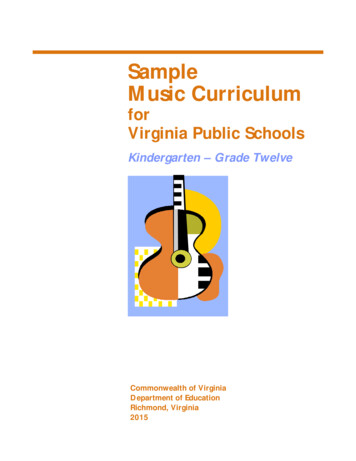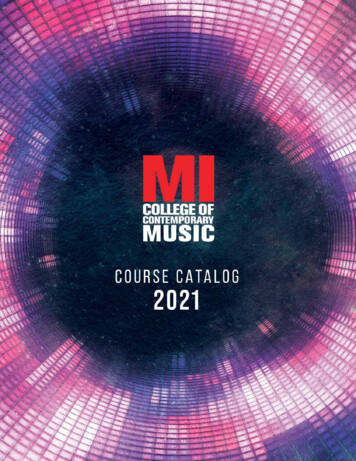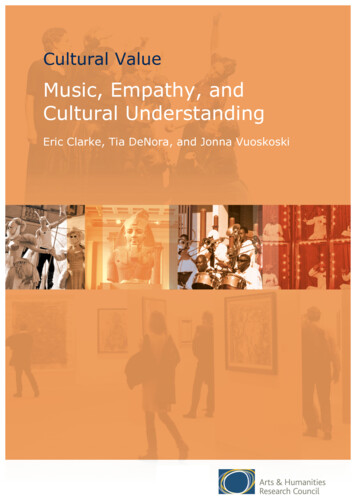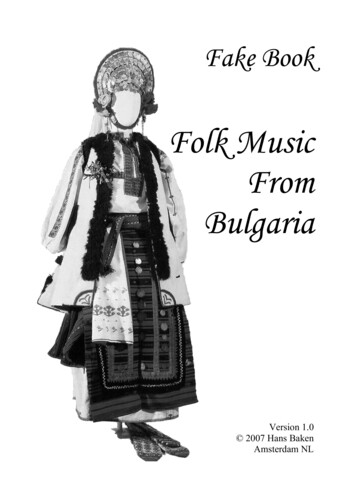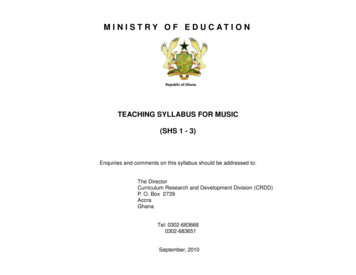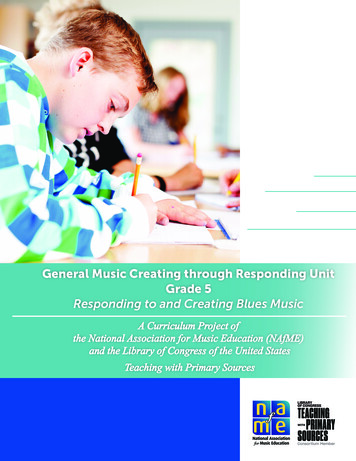
Transcription
General Music Creating through Responding UnitGrade 5Responding to and Creating Blues MusicA Curriculum Project ofthe National Association for Music Education (NAfME)and the Library of Congress of the United StatesTeaching with Primary Sources
ACKNOWLEDGMENTSPERSONNEL, LIBRARY OF CONGRESS GRANT — WRITING RESPONDING UNITS 2018–2019PROJECT DIRECTOR Johanna J. SiebertCOMPOSITION/THEORY WRITING TEAM Carolyn Bennett, North Stonington, CT, Team Chair Terrence E. Bacon, North Chili, NY Lisa Cookson, Wichita, KSGENERAL MUSIC WRITING TEAM Wendy Barden, Minnetonka, MN, Team Chair Steve Kennedy, New Orleans, LA Richard Maxwell, Phoenix, AZ Susan Osborn, Bear, DE David Potter, Lansing, MI Matt Warren, Webster, NYSpecial thanks to the Library of Congress for the generous grant on Teaching with Primary Sources (TPS),which made this resource possible.G E N E R A L M USIC RE SP O N D I N G U N I T G R A D E 5 NATIONAL ASSO CIATION for MUSIC EDUCATION2
TABLE OF CONTENTSOverview of NAfME/Library of Congress Responding Units . . . . . . . . . . .4Overview of Grade 5 General Music Unit on Responding to andCreating Blues Music. . . . . . . . . . . . . . . . . . . . . . . . . . . . . . . . . . . . . . . . . . . .4Prerequisite Knowledge and Experiences. . . . . . . . . . . . . . . . . . . . . . . . . . .5Instructional Goals . . . . . . . . . . . . . . . . . . . . . . . . . . . . . . . . . . . . . . . . . . . . .5Embedded Inquiry Model: KWL . . . . . . . . . . . . . . . . . . . . . . . . . . . . . . . . . . .6National Core Arts Standards in Music (2014) . . . . . . . . . . . . . . . . . . . . . . .7Formative/Summative Assessments . . . . . . . . . . . . . . . . . . . . . . . . . . . . . . .9Library of Congress Resource Links . . . . . . . . . . . . . . . . . . . . . . . . . . . . . . .10LESSONSLesson 1:Experiencing and Interpreting Blues. . . . . . . . . . . . . . . . . . . . . . . . . .12Lesson 2:Describing and Contextualizing the Blues. . . . . . . . . . . . . . . . . . . . .16Lesson 3:Creating and Developing Blues. . . . . . . . . . . . . . . . . . . . . . . . . . . . . .22Lesson 4:Presenting and Synthesizing Blues. . . . . . . . . . . . . . . . . . . . . . . . . . .27HANDOUTS . . . . . . . . . . . . . . . . . . . . . . . . . . . . . . . . . . . . . . . . . . . . . . . . . . .32G E N E R A L M USIC RE SP O N D I N G U N I T G R A D E 5 NATIONAL ASSO CIATION for MUSIC EDUCATION3
OVERVIEW OF NAfME/LIBRARY OF CONGRESS RESPONDING UNITSThese units are based on the 2014 National Music Standards (nafme.org/standards). These Standards areall about music literacy, since they emphasize conceptual understanding in areas that reflect the actualprocesses in which musicians engage; they cultivate a student’s ability to carry out the three ArtisticProcesses of Creating, Performing, and Responding while aligning with the ideal of Connecting to theirworld and the world around them. These are the processes that musicians have followed for generations,even as they connect through music to their selves and their societies.OVERVIEW OF GRADE 5 GENERAL MUSIC UNIT ON RESPONDING TO AND CREATING BLUES MUSICThis Library of Congress Teaching with Primary Sources (TPS) Unit is aligned with the Artistic Processes of(1) Responding, defined as understanding and evaluating how music conveys meaning, and (2) Creating,the application of musical concepts to develop original musical ideas. Through application of inquiry-basedinstructional strategies linked to essential questions embedded in the Responding and Creating Processcomponents (Select, Analyze, Interpret, Evaluate/Imagine, Plan and Make, Revise and Evaluate, Present),students understand how creators manipulate the elements of music to convey expressive intent relatedto specific contexts (social, cultural, historical). Acquisition of music knowledge and skills leads to studentsbecoming independent thinkers and creators.The Process components need not be linear in instruction and student learning; rather, they can bepresented in an order appropriate to the integration of specific content and knowledge as determined byeach grade level and curricular focus.This general music unit music-making activities and responding activities use the genre of the blues. Threeaudio examples of blues compositions from the Library of Congress will be used as primary resources.While the time frame, like the creative process, is flexible, the lessons in this unit can be done inapproximately 3–4 hours of total instruction time. The first lesson is a readiness lesson, where the studentswill be asked to write or record a critical account of experiences in their life. Students will then listen toa blues song that provides a critical account in the lyrics. Potential examples include, but are not limitedto, “We Don’t Have No Payday Here,” “I Heard What You Said About Me,” and “Obey the Ration Laws.”The intent is to establish familiarity with critical narratives in blues songs. Reinforcing and extending thematerial over several lessons will allow for student reflection and retention. This will also allow studentswho were absent in a previous lesson to have the opportunity to experience songs within the blues genre.The Readiness activities for the blues songs used in this unit include multiple listening examples that canbe teacher-selected from various resources. While it focuses on the Responding Artistic Process, this unitwill apply the understandings gained to the idea of responding through creating. Additionally, other musicmaking experiences separate from the blues activities are encouraged for exploration within the lessons.This approach will help keep students engaged in the overall music-making and learning process.LessonTitleEstimatedDuration1Experiencing andInterpreting Blues45–60 min2Describing andContextualizingBlues45–60 min3Creating andDeveloping Blues45–60 min4Presenting andSynthesizing Blues45–60 minDescriptionFinding hopes, dreams, and concerns in blues recordingsDistinguishing blues recordings and the role of civics in recordingsImprovising, informing, and practicing 12-bar bluesPresenting original student works based on the bluesG E N E R A L M USIC RE SP O N D I N G U N I T G R A D E 5 NATIONAL ASSO CIATION for MUSIC EDUCATION4
PREREQUISITE KNOWLEDGE AND EXPERIENCES Students should have experience discussing history and participating in collaborative discussions. Students should have a working knowledge of grade-level musical terms. Students should have experience comparing and contrasting musical genres. Students should have experience creating short pieces of music. Students should have experience explaining why music interests them. Students should have experience discussing purposes for which music was/is created. Students can describe a composition and/or arrangement. Students can explain how lyrics reflect intent. Students have experience analyzing the elements of a musical experience. Students have experience evaluating musical works and performances using specific criteria based onthe elements of music. Students have experience reading and/or listening to musical and lyrical literature. Students have experience improvising music.Note: This unit contains old recordings that have been digitized from the Library of Congress collections.It may be necessary to discuss early recording technology with students before beginning the unit so thatthey understand that the crackle and hissing sounds are not part of the music examples.INSTRUCTIONAL OBJECTIVES/STUDENT “I CAN” STATEMENTS I can critically analyze a blues song and reflect on its cultural context. I can critically listen to my own compositions as well as those of others. I can reflect on blues compositions using appropriate musical terms. I can use musical concepts to describe musical experiences within the blues. I can make connections between personal experiences and the experiences described within bluescompositions. I can explore the purposes and contexts of blues compositions. I can create a final composition or arrangement based on the blues. I can improvise 12-bar blues alone and/or with a group. I can use feedback to make changes to my 12-bar blues creation. I can compare and contrast blues music to other genres.G E N E R A L M USIC RE SP O N D I N G U N I T G R A D E 5 NATIONAL ASSO CIATION for MUSIC EDUCATION5
EMBEDDED INQUIRY MODEL: KWLKnow: What do students already know about the pieces after listening? Elements of music including harmony, tempo, melody, rhythm, and form. Guidelines for critically analyzing music. Guidelines for collaborative feedback in student compositions. Evaluate musical works and performances using specific criteria based on musical elements.Want: What do they want to know about the genre? Deeper understanding of the blues in relation to other musical genres through analysis and reflection.Learn: Students apply what they have learned about the blues. Students create blues songs that reflect their understanding of the elements and narratives found withinthe blues.G E N E R A L M USIC RE SP O N D I N G U N I T G R A D E 5 NATIONAL ASSO CIATION for MUSIC EDUCATION6
NATIONAL CORE ARTS STANDARDS IN MUSIC (2014)Creating through RespondingThe Responding Process addressed in this unit is detailed below.Select: Choose music appropriate for a specific purpose or context.Individuals’ selection of musical works is influenced by their interests, experiencesEnduringUnderstanding understandings, and purposes.How do people choose music to –Demonstrate and explain, citing evidence, how selected music connectsStandardto and is influenced by specific interests, experiences, purposes, or contexts.Student “I Can” I can use musical concepts to describe musical experiences within the blues.StatementAnalyze: Analyze how the structure and context of varied musical works inform the repsonse.Response to music is informed by analyzing context (social, cultural, and historical) andEnduringUnderstanding how creators and performers manipulate the elements of music.How does understanding the music help us make decisions about strate and explain, citing evidence, how responses to music areStandardinformed by the structure, the use of the elements of music, and context, such as social,cultural, and historical.Student “I Can” I can make connections between personal experiences and the experiences describedwithin blues compositions.StatementI can critically analyze a blues song and reflect on its cultural context.Interpret: Support interpretations of musical works that reflect creators’/performers’ expressive intent.Through their use of elements and structures of music, creators and performers provideEnduringUnderstanding clues to their expressive intent.How can we tell what the composers and performers mean to say through their monstrate and explain how the expressive qualities (such as dynamics,Standardtempo, timbre, and articulation) are used in performers’ and personal interpretations toreflect expressive intent.Student “I Can” I can reflect on blues compositions using appropriate musical terms.I can explore the purposes and contexts of blues compositions.StatementEvaluate: Support evaluations of musical works and performances based on analysis, interpretation,and established criteria.The personal evaluation of musical work(s) and performance(s) is informed by analysis,EnduringUnderstanding interpretation, and established criteria.How do we judge the quality of a musical work or a—Evaluate musical works and performances, applying established criteria,Standardand explain appropriateness to the context, citing evidence from the elements of music.Student “I Can” I can critically listen to my own compositions as well as those of others.StatementG E N E R A L M USIC RE SP O N D I N G U N I T G R A D E 5 NATIONAL ASSO CIATION for MUSIC EDUCATION7
The Creating Process addressed in this unit is detailed below.Imagine: Generate musical ideas for various purposes and contexts.The creative ideas, concepts, and feelings that influence musicians’ work emerge from aEnduringUnderstanding variety of sources.How do musicians generate creative provise rhythmic, melodic, and harmonic ideas, and explain connectionStandardto specific purpose and context (such as social, cultural, and historical).Student “I Can” I can improvise 12-bar blues alone and/or with a group.StatementPlan and Make: Select and develop musical ideas for defined purposes and contexts.Musicians’ creative choices are influenced by their expertise, context, and expressiveEnduringUnderstanding intent.How do musicians make creative ��Demonstrate selected and developed musical ideas for improvisations,Standardarrangements, or compositions to express intent, and explain connection to purposeand context.Student “I Can” I can compare and contrast blues music to other genresStatementEvaluate and Refine: Evaluate and refine selected musical ideas to create musical work(s) that meetappropriate criteria.Musicians evaluate and refine their work through openness to new ideas, persistence,EnduringUnderstanding and application of appropriate criteria.How do musicians improve the quality of their creative luate, refine, and document revisions to personal music, applyingStandardteacher-provided and collaboratively-developed criteria and feedback, and explainrationale for changes.Student “I Can” I can use feedback to make changes to my 12-bar blues creation.StatementPresent: Share creative musical work that conveys intent, demonstrates craftsmanship, and exhibitsoriginality.Musicians’ presentation of creative work is the culmination of a process of creation andEnduringUnderstanding communication.When is creative work ready to esent the final version of personal created music to others thatStandarddemonstrates craftsmanship, and explain connection to expressive intentStudent “I Can” I can create a final composition or arrangement based on the blues.StatementG E N E R A L M USIC RE SP O N D I N G U N I T G R A D E 5 NATIONAL ASSO CIATION for MUSIC EDUCATION8
ADDITIONAL ESSENTIAL QUESTIONS What inspires someone to create a piece of music? How does culture affect music? What criteria do we use to evaluate a performance? How does familiarity with a piece of music affect how we respond? Why do people have different interpretations of the same piece? How can appropriate music vocabulary help in discussing musical evaluation with others?ADDITIONAL ENDURING UNDERSTANDINGS The depth of musical knowledge one possesses impacts how, and to what degree, one analyzes,describes, and evaluates music. Music is an important element of the historical and cultural record of humankind.FORMATIVE/SUMMATIVE ASSESSMENTSResponding Worksheets are embedded into each lesson. Lesson 1: Responding Worksheet 1 Lesson 2: Responding Worksheet 2 Lesson 3: Responding Worksheet 4 Lesson 4: Responding Worksheet 4RUBRICS FOR CREATING ASSESSMENTS Responding Scoring Device Imagine Scoring Device Final Composition Scoring Device Evaluate to Refine WorksheetG E N E R A L M USIC RE SP O N D I N G U N I T G R A D E 5 NATIONAL ASSO CIATION for MUSIC EDUCATION9
LIBRARY OF CONGRESS LINKSNote: This unit contains early recordings and videos that have been digitized from the Library of Congresscollections. It may be necessary to discuss old recording technology with students before beginning theunit so they understand that the crackle and hissing sounds are not part of the original performances butare a result of the technology of the period. Article description of the blues, the-day/blues/ Alan Lomax, https://www.loc.gov/item/afc1939007 afs02484a/ “Joe Turner Blues,” https://www.loc.gov/item/jukebox-19795/ “We Don’t Have No Payday Here,” https://www.loc.gov/item/lomaxbib000584/ “I Heard What You Said about Me,” https://www.loc.gov/item/lomaxbib000484/ “Obey the Ration Laws” (Buster Ezell), https://www.loc.gov/item/ftvbib000083/ “Joe Louis” (Buster Ezell), https://www.loc.gov/item/ftvbib000108/ “War Song” (James Willis), https://www.loc.gov/item/ftvbib000104/ “Memphis Blues of Mister Crump” (W.C. Handy, 1914), https://www.loc.gov/item/ihas.100010716/ “Has Anybody Seen My Corinne?” (Graham, 1918), https://www.loc.gov/item/ihas.100010723/ “Bell Hop Blues” (Al Bernard, 1919), https://www.loc.gov/item/jukebox-33747/ Sheet Music ,Spencer Williams, “Tishomingo Blues,” https://www.loc.gov/item/ihas.100010523/ “Blue Suede Shoes,” https://catalog.loc.gov/vwebv/search?searchCode LCCN&searchArg 2008644313&searchType 1&permalink yDIFFERENTIATION STRATEGIES (as listed in the Model Cornerstone Assessments for 5th Grade) Pre-assess to determine levels of student prior knowledge and abilities determine and teach to reduce learning gaps allowing alternative forms of communicating expectationsto students as needed create independent enrichment/enhanced work for students who show mastery group students to accommodate learning needs use provocative, complex questioning to stimulate high level thinking devise open-ended tasks to allow students of all ability levels to achieve success at their own levels tier tasks to address levels of abilities and support students within each tier, assure that students are given choice in tasks in order to address their learning styles, interests, etc. allow students to respond to tasks in alternative ways if the defined response in the MCA hinders anindividual’s means of demonstrating learning.G E N E R A L M USIC RE SP O N D I N G U N I T G R A D E 5 NATIONAL ASSO CIATION for MUSIC EDUCATION10
ADDITIONAL RECOMMENDED RESOURCES Goodkin, Doug., comp. All Blues: Jazz for the Orff Ensemble. San Francisco, CA: Pentatonic Press, 2012.Print. Goodkin, Doug., comp. Now’s The Time: Teaching Jazz to All Ages. San Francisco, CA: Pentatonic Press,2004. Print. Lange, Diane M., comp. Together in Harmony: Combining Orff Schulwerk and Music Learning Theory.Chicago, IL: GIA Publications, 2005. Print. Internet access Instruments Recording device GarageBand, Soundation, and/or related looping software CD Player or iPod/speakers Smart board or other projection resourceG E N E R A L M USIC RE SP O N D I N G U N I T G R A D E 5 NATIONAL ASSO CIATION for MUSIC EDUCATION11
LESSON 1: EXPERIENCING AND INTERPRETING THE BLUES (45–60 MINUTES)INSTRUCTIONAL OBJECTIVES/STUDENT “I CAN” STATEMENTS I can reflect on blues compositions using appropriate musical terms. I can explore the purposes and contexts of blues compositions. I can make connections between personal experiences and the experiences described within bluescompositions.ESSENTIAL QUESTIONS How does understanding the structure and context of music inform a response? How do we discern the musical creators’ and performers’ expressive intent?SPECIFIC MUSIC STANDARDS Demonstrate and explain, citing evidence, how responses to music are informed by the structure, theuse of the elements of music, and context, such as social, cultural, and historical (MU:Re7.2.5a). Demonstrate and explain how the expressive qualities (such as dynamics, tempo, timbre, andarticulation) are used in performers’ and personal interpretations to reflect expressive intent(MU:Re8.1.5a).LEARNING SEQUENCEA. Analysis of hopes, dreams, and blues music (20–30 minutes) Ask students to write a list of hopes, dreams, and concerns (Question 1 in handout). Write a list of your own hopes, dreams, and concerns on the board. Ask students to compare and contrast hopes/dreams/concerns with yours on the board (Question 2 inhandout). Put the song lyrics on the board:Song LyricsIt’s a long road,But I’m gonna find the end.It’s a long road,But I’m gonna find the end.And when I get back,I’m gonna shake hands with the friends.G E N E R A L M USIC RE SP O N D I N G U N I T G R A D E 5 NATIONAL ASSO CIATION for MUSIC EDUCATION12
Source: Library of Congress Unpublished Archives. Ask students to write a list of hopes, dreams, and concerns that they observe in the lyrics (Question 3 inhandout). Ask students to compare/contrast the lyrics of the song with their written hopes and dreams. Ask students to predict how the song “Long Road” will sound based on the lyrics they see (tempo, key,instruments, etc.): Present students with a recording of the song “Long Road” (optional recording: https://www.youtube.com/watch?v 57Nw0RYMGTw). Ask students to what they noticed about the recording (expression, form, tempo, key, instruments, lyrics,melody, etc.), and ask them to write it down (question 4 in handout)B. Performance and creating new lyrics (25–30 minutes, as time allows). Teach students how to sing the song (optional accompaniment:https://www.youtube.com/watch?v tlMmgLx9ShI). Model for students how to set the melody for “Long Road” to new lyrics based on personal hopes/dreams/concerns described by the class. Ask the students for new lyrics based on the hopes/dreams/concerns that they described in class. Perform the new lyrics together as a class.POSSIBLE EXTENSIONS Teacher could play a 12 bar-blues progression on instrument or sing the bass line instead of using arecording. This link provides a basic overview of 12-bar s12bar.html While the piece was written in Eb, the teacher may adjust to a different key if needed. For more descriptions of the blues, check out these articles from the Library of Congress:– Article description of the blues rticles-andessays/– musical-styles/popular-songs-of-the-day/blues/G E N E R A L M USIC RE SP O N D I N G U N I T G R A D E 5 NATIONAL ASSO CIATION for MUSIC EDUCATION13
LESSON 1 HANDOUT: HOPES, DREAMS, AND CONCERNS1. Write a list of your hopes, dreams, and concerns below.HOPESDREAMSCONCERNS2. Take a look at your teacher’s list of hopes, dreams, and concerns. Do you see anything on your teacher’slist that looks similar to yours? Circle at least three words on your list that are the most similar to yourteacher’s list. Do you see anything on your teacher’s list that looks different from yours? Draw a squarearound at least three words on your list that are the most different from your teacher’s list.3. Take a look at the lyrics and listen to the song presented by your teacher. Write down some of the hopes,dreams, and concerns that you see and hear in the song.HOPESDREAMSCONCERNS4. What else did you notice about the music (expression, form, etc.)?G E N E R A L M USIC RE SP O N D I N G U N I T G R A D E 5 NATIONAL ASSO CIATION for MUSIC EDUCATION14
LESSON 1 HANDOUT: HOPES, DREAMS, AND CONCERNS(FORMATIVE ASSESSMENT)RUBRIC: Hopes, Dreams, and Concerns Handout, Question 3AchievementLevel 1Level 2Level 3 Meets Level 4 nCriterionInterpret – Support expressive qualities of musical works that reflect expressive intent.InterpretingQualities(Assessment 1)Provided limiteddescription ofhow the lyricsreflect theexpressive intentof the music,which is tocommunicatethemes pertainingto the blues.Describeswith someinaccuracies howthe lyrics reflectthe expressiveintent of themusic, which isto communicatethemes pertainingto the blues.Accuratelydescribed howthe lyrics reflectthe expressiveintent of themusic, which isto communicatethemes pertainingto the blues.Accuratelydescribed withexpanded detailor insight howthe lyrics reflectthe expressiveintent of themusic, which isto communicatethemes pertainingto the blues.“I can ”“I can describethemes found inblues music.”“I can describethemes found inblues music withsome accuracy.”“I can describethemes found inblues music withaccuracy.”“I can describethemes found inblues music withaccuracy anddetail.”PerformanceStandardsDemonstrateand explain howthe expressivequalities (suchas dynamics,tempo, timbre, andarticulation) areused in performers’and personalinterpretationsto reflectexpressive intent.(MU:Re8.1.5a)RUBRIC: Hopes, Dreams, and Concerns Handout, Question 4AchievementLevel 1Level 2Level 3 Meets Level 4 nCriterionAnalyze– Analyze the use of the elements of music in the performance.Reflection(Assessment 2)Identifiedelements ofmusic andstructuralcomponentswithoutconnectionto informedresponse.Suggestedgeneral ideas asto how responseis informedby elementsof music andstructuralcomponents.Cited evidencehow responseis informedby elementsof music t intohow responseis informedby elementsof music andstructuralcomponents.“I can ”“I can talk aboutmusic.”“I can respond tomusic by offeringgeneral ideas.”“I can respondto music bydescribing it withevidence.”“I can respondto music bydescribing it withevidence andoffering originalideas.”PerformanceStandardsDemonstrate andexplain, citingevidence, howresponses to musicare informed by thestructure, the useof the elements ofmusic, and context(such as social,cultural, andhistorical).(MU:Re8.1.5a)(adapted from https://nafme.org/wp-content/files/2014/11/Grade 5 GenMus Responding MCA.pdf)G E N E R A L M USIC RE SP O N D I N G U N I T G R A D E 5 NATIONAL ASSO CIATION for MUSIC EDUCATION15
LESSON 2: DESCRIBING AND CONTEXTUALIZING THE BLUESINSTRUCTIONAL OBJECTIVES/STUDENT “I CAN” STATEMENTS I can reflect on blues compositions using appropriate musical terms. I can explore the purposes and contexts of blues compositions. I can make connections between personal experiences and the experiences described within bluescompositions.ESSENTIAL QUESTIONS How does understanding the structure and context of music inform a response? How do we discern the musical creators’ and performers’ expressive intent?SPECIFIC MUSIC STANDARDS Demonstrate and explain, citing evidence, how responses to music are informed by the structure, theuse of the elements of music, and context, such as social, cultural, and historical (MU:Re7.2.5a). Demonstrate and explain how the expressive qualities (such as dynamics, tempo, timbre, andarticulation) are used in performers’ and personal interpretations to reflect expressive intent(MU:Re8.1.5a).LEARNING SEQUENCEA. Analysis of hopes, dreams, and blues music (20–30 minutes) Ask students to write a list of ways to make the world a better place (Question 1 in handout). Write a list of your own ways on the board. Ask students compare and contrast their ways with yours on the board (Question 2 in handout). Put the song lyrics on the board:Song LyricsMister rich man, rich man.Open up your heart and mind.Give a poor man a chance.Help stop these hard, hard times.G E N E R A L M USIC RE SP O N D I N G U N I T G R A D E 5 NATIONAL ASSO CIATION for MUSIC EDUCATION16
Source: Library of Congress Archives. Ask students to interpret the civic issues reflected in the song(Handout 1, Question 4). Ask students to compare/contrast the civics of the song with theirown list (Handout 1, Question 5). Explain that the author of this song (Bessie Smith) was also the authorof “Long Road” from the previous lesson, and that both songs areblues songs. (Optional: Show image.) Ask students to predict how the song will sound based on lyrics andknowledge from the previous lesson (tempo, key, instruments, etc.). Play a recording of the song for students (optional recording:https://www.youtube.com/watch?v MHYtg7liLKo) Ask students to describe musical and civic elements of the recording(tempo, key, instruments, lyrics, melody, etc.) (Handout 1,Question 6). Discuss with students the historical context for the recording(i.e. The Great Depression, The Harlem Renaissance, etc.).Portrait of Bessie Smith holdingfeathers. Photograph by CarlVan Vechten, 1936. Prints &Photographs Division, Library ofCongress. Van Vechten’s portrait ofBessie Smith is also featured in theLibrary’s online exhibit,Jazz Singers.B. Comparing and contrasting music—whole-group/independent practice (25–30 minutes) Play for students a “non-blues” recording with similar civic themes (optional accompaniment:https://www.youtube.com/watch?v no5YWKY6eOsI). Ask students to describe musical and civic elements of the recording. Work with students to compare and contrast both recordings. Explain to students why the “non-blues” song is not a blues song. Ask students to select their own song from a list to compare and contrast to “Poor Man’s Blues,”explaining whether or not their selected song is a blues song (Handout 2).G E N E R A L M USIC RE SP O N D I N G U N I T G R A D E 5 NATIONAL ASSO CIATION for MUSIC EDUCATION17
LESSON 2, HANDOUT 1: MAKING THE WORLD A BETTER PLACE(GUIDED PRACTICE)1. Write a list of ways to make the world a better place. Write it under “Your List.”2. Copy the list of ways that your teacher wrote. Write it under “Teacher’s List.”3. If any ideas between your list and your teacher’s list were similar, connect with a line.4. Take a look at the lyrics and listen to the song presented by your teacher. Write under “singer’s list” someof the ways that song suggests that the world could be made better.Source: Library of Congress Archives.5. If any ideas between your list and the song’s list were similar, connect with a line.6. Did you notice any more suggestions in the recording? Write them under “singer’s list.”Teacher’s ListG E N E R A L M USIC RE SP O N D I N G U N I T G R A D E 5 Your ListSinger’s ListNATIONAL ASSO CIATION for MUSIC EDUCATION18
LESSON 2, HANDOUT 2: IS IT THE BLUES?(INDEPENDENT PRACTICE)1. Choose a song from a song library provided by your teacher. Write the name below.2. Describe the song below, including
I can explore the purposes and contexts of blues compositions. I can create a final composition or arrangement based on the blues. I can improvise 12-bar blues alone and/or with a group. I can use feedback to make changes to my 12-bar blues creation. I can compare a

